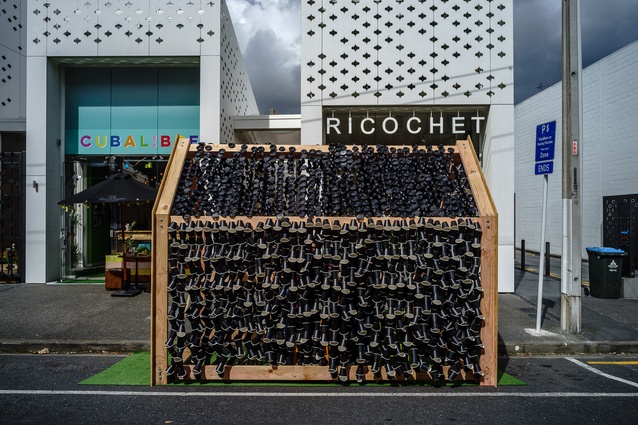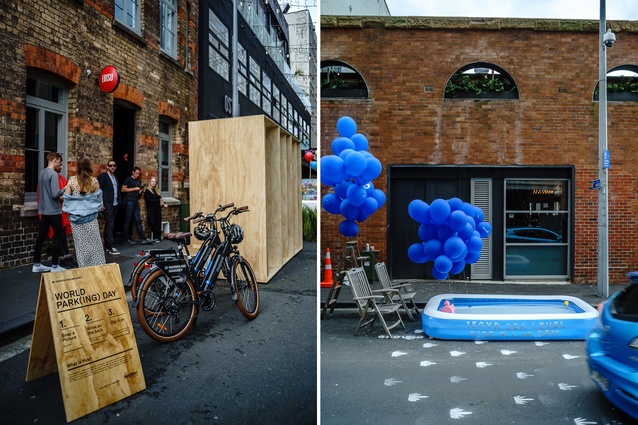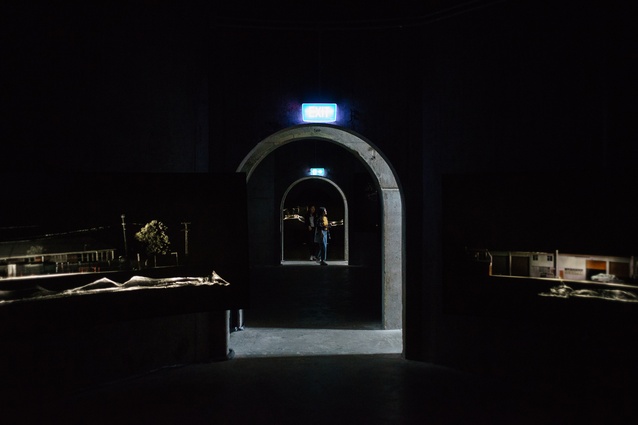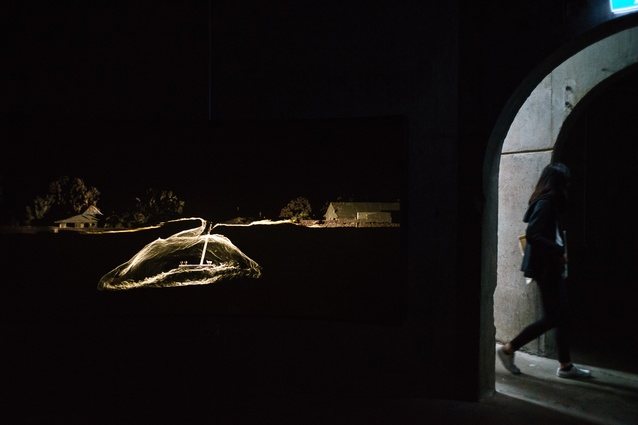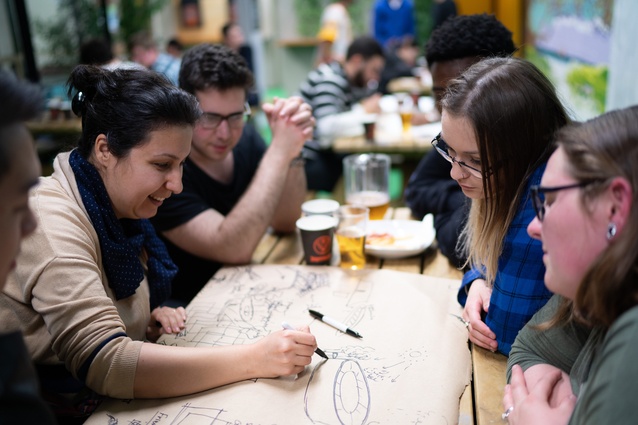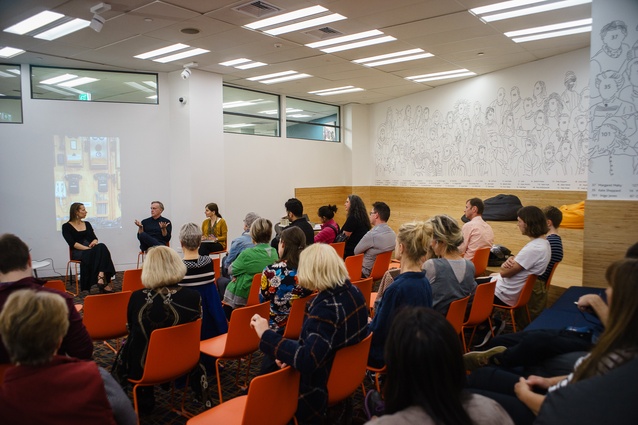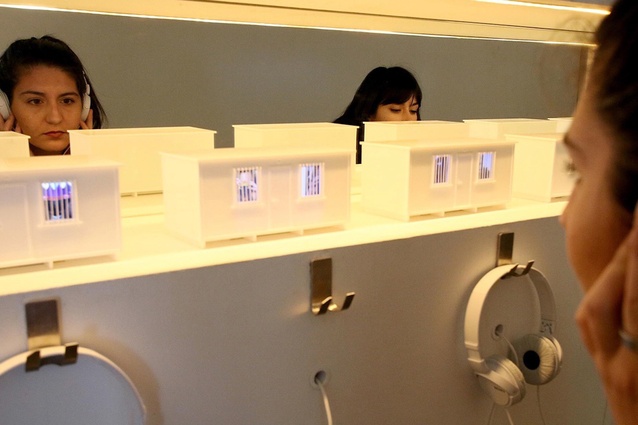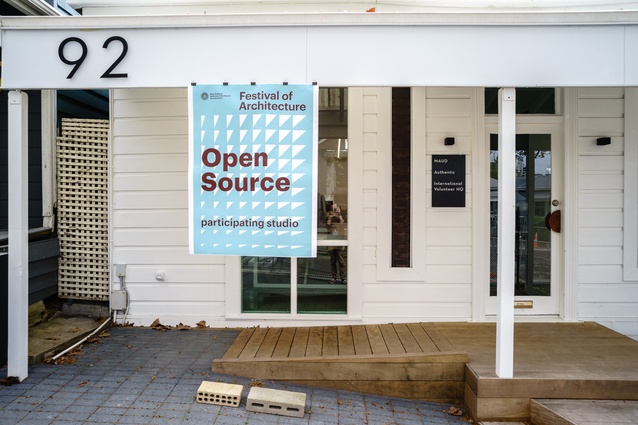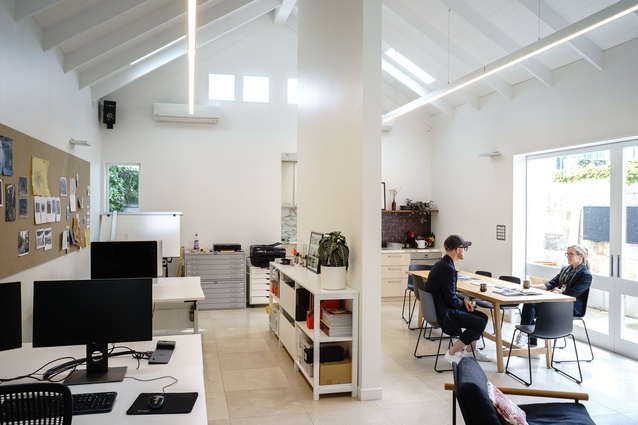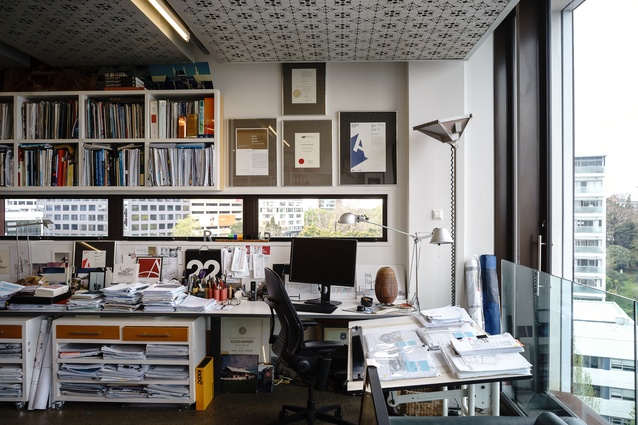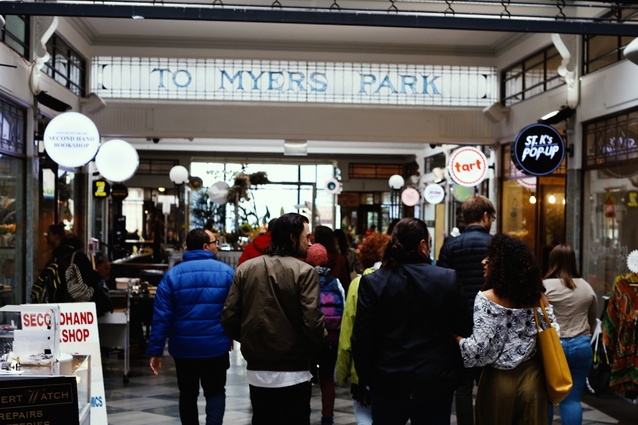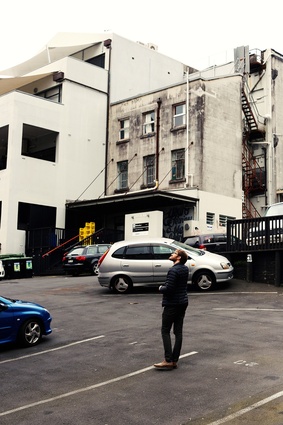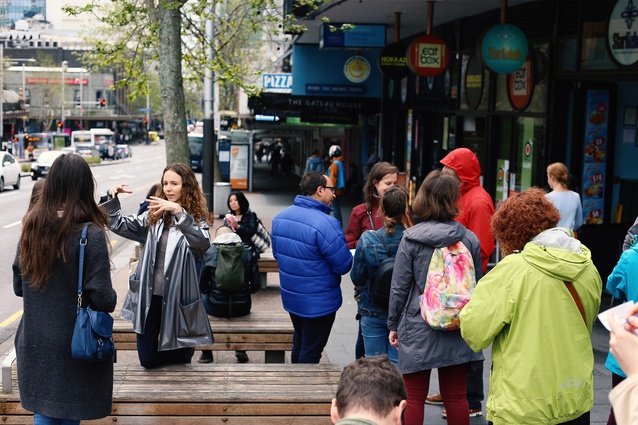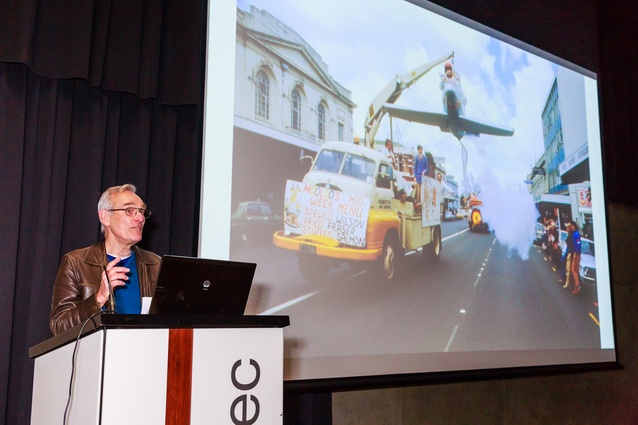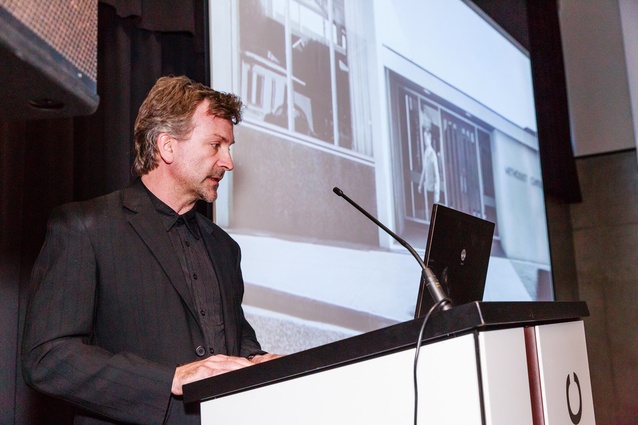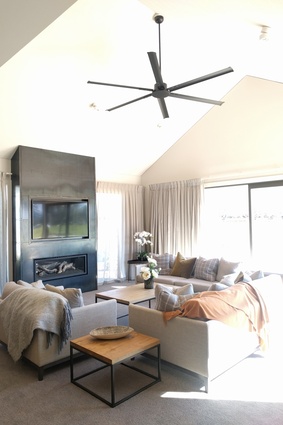2018 Festival of Architecture: Wrap-up
Here’s what happened during the final weekend of the 2018 Festival of Architecture:
Auckland
Walking – One Sense at a Time: Sight-Walk
18 and 20 September
Auckland CBD
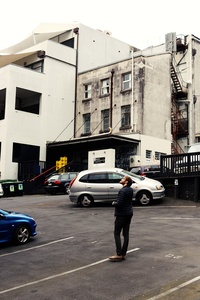
Led by myself, an artist and cultural geographer, the project was also supported by Auckland Council and Splice.
The concluding walk of the ‘Walking – One Sense at a Time’ series took place last Tuesday and Saturday. After walking the city using the lense of smell/taste, touch and sound in previous walks, we’ve finished with the sight-walk. We explored Auckland CBD by intently staring at the objects and interactions taking place in the streets. We looked at the human and non-human in the city, slowed down to notice the things close up and far in the distance and discussed the implications of paying attention to the streets we share.
These walks were less of a classical city tour and more a guided exploration and mapping exercise. While being genuinely fun, the walks were also an insightful experience, giving rise to some important questions: How can the city be functioning to meet the needs of its humans as well as other lively creatures? What are the ways that colors and fonts contribute to ‘gendering’ a space? Which aspects of city planning incite pausing and thinking and which direct people into consumerist practices? How does our direct sensory experience connect to broader social issues?
– Iryna Zamuruieva

As You Will: Carnegie Libraries of the South Pacific
Wednesday, 20 September
Auckland Central City Library
Auckland’s Central City Library hosted the launch of As You Will: Carnegie Libraries of the South Pacific. Te Tuhi curator Gabriela Salgado, led architect Dr Charles Walker and artist Mickey Smith in a conversation about the life of Andrew Carnegie and his establishment of over 2,500 free public libraries worldwide.
Charles and Mickey shared their personal stories growing up using Carnegie Libraries in Grangemouth, Scotland and Duluth, Minnesota, USA. The buildings made an impression on both speakers from a very young age.
The concept of a free library system was new for many of the communities that received library funding in New Zealand. The general plan of the open public spaces was influenced by Andrew Carnegie’s funding conditions so much so that his secretary, James Bertram, issued communities and their architects a “Guide to Library Bilding.”
As You Will is available for purchase from Nationwide Books. A celebration for the publication will be held at the Depot Artspace in Devonport from 2-4pm on Saturday, 29 September.
– Mickey Smith, artist
24 Hour Design Challenge
21 and 22 September
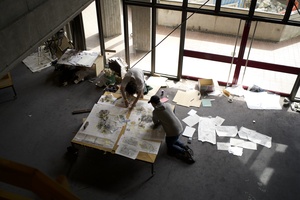
After a potentially sleepless night, 100 students from around the country gathered at the Wine Chambers in Auckland to present their projects from the 24 Hour Design Challenge to the awaiting jury. Participants were charged with creating a master plan for Huntly, the oft-forgotten town between Hamilton and Auckland.
Some groups chose to focus on housing, some on transport, some on education and still others on adaptive re-use of perhaps Huntly’s only recognisable landmark: the coal plant. In any case, the 13 groups all had to present their designs to the judging panel with a three-minute crit.
This may have been the most challenging portion of the day for some groups as the students were given additional briefs for how to present such as incorporating the word “tectonic” into each sentence or presenting like Sir David Attenborough. In the end, the judges crowned the group whose crit involved a full-blown, Dr Seuss-style poem the winners for their confidence and clever animations.
– Ashley Cusick, ArchitectueNow editor
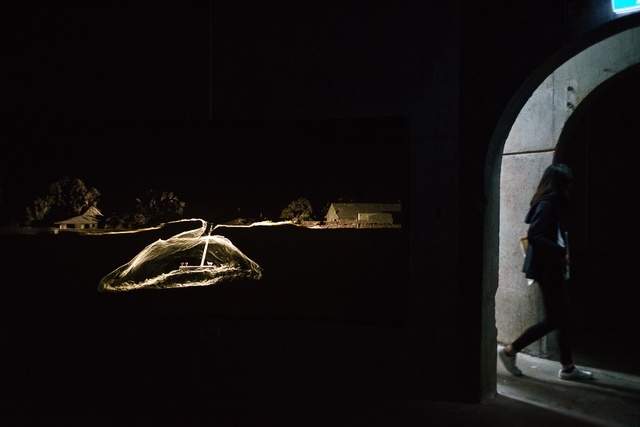
University of Auckland Architecture Student Exhibition
14-23 September
University of Auckland School of Architecture and Planning
Architecture School pin ups consists of two processes at work. We engage in skilful communication coupled with meritorious architectural proposition and when these become coherent you have a vigorous and successful project. This exhibition is exemplary of both aspects at play.
When reviewing the Student Exhibition a few things became apparent. Appreciating our bias, we were immediately captured by the hand drawings that are scattered throughout. A third year paper taken by Michael O’Sullivan helped to quantify pencil over print, but this is in no way a detriment to the digital. Colourful, highly aesthetic and fun, the digital work was as intricate as the hand drawing.
The models are a standout, even materiality trialling, bright plastic rectangular sheets look edible. Between mega towers and kindergartens the projects were vast and there seems to be no theme of drawing style, anything goes.
After viewing the exhibition at the University of Auckland, you will consider yourself lucky to have been privy to skilfully executed architectural propositions that look somewhat plausible to become realised, through executions of completely thought out forms. Although, perhaps we won’t be building a Cheese and Biscuit Factory or living in a Snow Globe anytime soon.
– Fritha Powell and Seth Schanzer, University of Auckland students
PhoneHome
14-28th September
Ellen Melville Centre
Near the windows to Freyburg place in the newly refurbished Ellen Melville Centre, there is a low, white plastic stele with seven small model prefab buildings on top. These buildings are instantly recognisable – bars on the windows, the single central door – they are the most economic solution to contain displaced, unwanted humans. Each of the models contains a smartphone positioned as a screen on the back wall of the unit, we are invited to kneel and peer to view the imagery through the tiny barred windows.
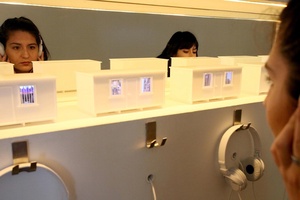
Audio accompanies each of the video works which deal variously with displacement – a boy’s voice waivers as he sings at his own birthday party so far from home; on a rocky shore an emergency blanket wrapped around a human figure crackles in the wind, the sound and enveloping triggers our memory of the fire that Iranian asylum seeker Omid Masoumali set on himself in 2016 in protest to the conditions in Nauru; we hear gentle lapping of waves as bodies lie motionless in the sea. Not all ‘real’, but not all staged – the power of the tiny screen to bring these experiences into our lives, to connect us to them, and also them to their families, friends and communities becomes clear. This experience is underscored through this apparatus for viewing, we can hardly get the full picture, but the question begs, what else do we really need to know?
Removing the headphones and regaining posture, one is left with a sense of distance, briefly measured by the relative comfort and security of our own bodies, smartphone and security device safely in our pocket. The PhoneHome designers, curators and contributing artists have captured a powerful and complex understanding of our relationship to these people and events through the medium of the smartphone and implicates architecture as part of the apparatus in our keeping distance.
– Kate Walker, Isthmus
Hamilton
Pecha Kucha
19 September

This event provided captivating stories of social activism and placemaking activation in Hamilton from the potent 1960’s through to the kinetic present.
In amongst the energy of the current young professionals and artists, such as muralist Paul Bradley, architect Daniel Smith, designer Alexander Wastney, and café-ist musician David Smith – who are each making subversive and highly visible interventions in the city’s fabric – there was also the reminder of the public social vigour of the 1970’s and 80’s.
Through photojournalist John Mercer’s black and white images, we viewed the protests against nuclear persuasion and Springbok tours, support for women’s rights and the Whina Cooper led hikoi, and the street theatre of a youthful Laird McGillicuddy Graeme Cairns and his kilted kin battling Alf’s Imperial Army. All in the hub of a populated Garden Place and a bustling Victoria Street.
Most moving were the talks of musician Jade Brown who is transforming young difficult lives through the purpose, pride and focus of acquiring skills in violin playing (true!), and of crafter Ryan Thorpe, having the survivors of the Kaikoura earthquake each design and fabricate their own working longboard.
Pecha Kucha 37 was sponsored by another of Hamilton’s current instigators of meaningful placemaking, Foster Construction. The audience left well-stimulated and primed.
– Antanas Prucuta, architect and Pecha Kucha curator
Whanganui
Various events
It is almost impossible to avoid the topic of housing anymore. Dinner parties are served with speculative comments on the ‘market’, and passing-by conversation with whoever makes your coffee, delivers your mail or packs your groceries is tainted by discussing whether you’re ‘on’ or ‘off’ the ladder. Even your parents, who might comfortably own their own three bedroom home with a separate lounge and north facing views and who quietly avoid the topic of capital gains, find a way to grumble about it.
So, how do we really overcome some of the issues at the heart the dining table? On Friday 21 September Bill McKay (University of Auckland) helped an eager-eared crowd look back on the history of state housing in New Zealand and provided examples of how owning your own home was and can be achieved.
The engaging presentation went on to discuss the current housing issues today and offered possibilities for fixing the problem on everyone’s lips. It was followed by a healthy panel discussion led by Frank Stark (Whanganui Regional Museum), hosting Christina van Bohemen and Aaron Sills (Sills van Bohemen), and Marie McKay (Te Puni Kōkiri).
The next day during open studios, enthusiasts were given the opportunity to visit ‘Dogbox’, the home and office of one half of Patchwork Architecture.
– Natalie Bradburn, Dalgleish Architects
Queenstown
Three Roofs: Ted McCoy Lecture Series
21 September
Queenstown was an apt place to attend Christopher Kelly’s Ted McCoy lecture, Three Roofs, as two out of three of the roofs in question are in Otago. Founding principal of Architecture Workshop in Wellington, Kelly presented a detailed talk about the Peregrine Winery in Gibbston Valley, Lindis Lodge in the remote Ahuriri Valley, and the Waitomo Glowworm Caves Visitors Centre, talking through the conception, eccentricities, alterations and challenges in the designs, focusing mainly on the sculptural roofs that make these projects so exceptional.
With all three projects, once Kelly had talked through the multiple layers of design, physics, engineering and manipulation of materials that go into these sculptural forms, there was a collective utterance of amazement as the images of the finished projects came on screen. The humble descriptions of the processes involved in making these feats happen were confounding and almost made them sound as if they should have been relegated to the too-hard basket. However, the results were so beautiful, it threw them back into perspective and showed that sometimes the most difficult route can be the most rewarding.

– Camille Khouri, architecutre and design writer
Queenstown Country Club Open Day
22 September
Designed by Warren and Mahoney, the Queenstown Country Club is an upmarket retirement village located close to the twin suburbs of Lake Hayes Estate and Shotover Country. Saturday’s open day provided a chance to have a look through the show home, with the architects on hand to answer questions. The homes, each with two to three bedrooms, are designed with the climate in mind, with thermally broken aluminium joinery and underfloor heating.
The appearance is contemporary, with cedar and concrete clad exteriors and gabled roof forms. A steady stream of interested residents and visiting architects arrived on Saturday, some taking a stroll down the lane to see how construction was coming along.
– Camille Khouri, architecutre and design writer
See coverage from earlier in the festival here (Auckland events) and here (regional events), and read a reveiw of Allison Arieff’s Sir Ian Athfield Memorial Lecture here.

